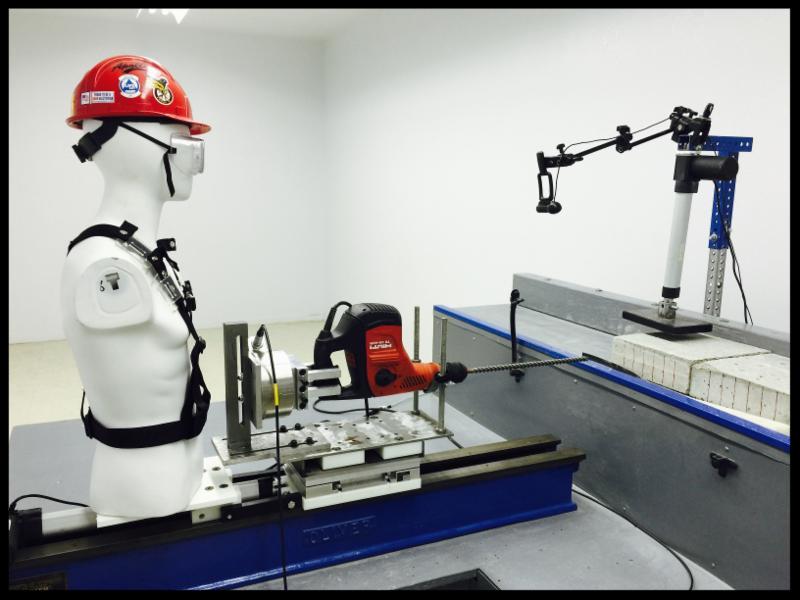|
CPWR UPDATE
|
September 2017
| |
From the Desk of Chris Trahan Cain, Executive Director
|
|
|
|
Research Findings: Sharp Drill Bits Reduce Health Risks & Increase Productivity
 Workers who perform concrete drilling are exposed to hazardous levels of noise, force, vibration and airborne silica dust. Reducing the risks associated with those hazards is the focus of a study by Dr. David Rempel, a member of CPWR's research consortium, and his research team at the University of California. Workers who perform concrete drilling are exposed to hazardous levels of noise, force, vibration and airborne silica dust. Reducing the risks associated with those hazards is the focus of a study by Dr. David Rempel, a member of CPWR's research consortium, and his research team at the University of California. Using a specially designed test bench (right) the researchers have conducted experiments using a common rotary hammer and carbide-tipped bit to isolate the effect of drill bit wear on worker exposure to these hazards. The tests found that bit wear reduced worker productivity -- holes took longer to drill -- while increasing the drill operator's exposure to silica dust, noise, force and vibration. Looked at another way, by swapping out worn bits promptly for sharp new ones, contractors can increase productivity while better protecting workers from occupational health hazards. The results have been published in a series of journal articles. Click on the links below for a one-page summary of the key findings:
|
|
TOOLS FOR SAFETY AND HEALTH
 OSHA enforcement of the new silica standard begins Sept. 23, 2017. Are you prepared? CPWR's Work Safely with Silica website is a one-stop source for information on silica hazards in construction and information to help with compliance, including an easy-to-use planning tool to create the silica exposure control plan required by the standard. The planning tool guides users through creating a job-specific plan that can be saved, edited, and shared in print or by email. OSHA enforcement of the new silica standard begins Sept. 23, 2017. Are you prepared? CPWR's Work Safely with Silica website is a one-stop source for information on silica hazards in construction and information to help with compliance, including an easy-to-use planning tool to create the silica exposure control plan required by the standard. The planning tool guides users through creating a job-specific plan that can be saved, edited, and shared in print or by email.
|
RESEARCH NEWS
Dust and fume exposure on the construction site harms workers years later
Workplace dust exposure is a serious matter for construction workers. A recent CPWR study examined medical screening results from 3,150 retired construction workers, comparing work history and lung function. Researchers found that those workers with higher cumulative exposures to vapors, gases, dusts and fumes on the job had poorer lung function in retirement -- and that their lung function continued to decline as they aged. CLICK HERE for a one-page summary of Longitudinal decline in lung function among older construction workers, which appeared in Occupational and Environmental Medicine.
|
Sept. 27 @ 2pm ET (45 min). Safe Students, Safe Workers: Construction Safety Programs in Post-Secondary Career Technical Education. Learn what post-secondary career technical education programs (CTE) in construction are doing and how to support development of students' skills for safe work in the classroom and on the job. What administrative systems, instructor support, curriculum content and teaching activities are needed? Presenters will share concrete examples and results from site visits, interviews, and a national survey of instructors and administrators in construction CTE programs in 2-year colleges, as well as a new guide of action steps and resources for administrators and instructors of CTE programs. CLICK TO REGISTER
|
The construction FACE Database -- Codifying the NIOSH FACE reports. Xiuwen Sue Dong, Julie A. Largay, Xuanwen Wang, Chris Trahan Cain, Nancy Romano, 2017. Journal of Safety Research
|
CO DOT schedules first work-zone autonomous vehicle tests, Construction Dive
Nanoparticles in Construction, Journeyman Roofer and Waterproofer
Construction struck-by deaths up 34% since 2010, Equipment World
|
|
|
|